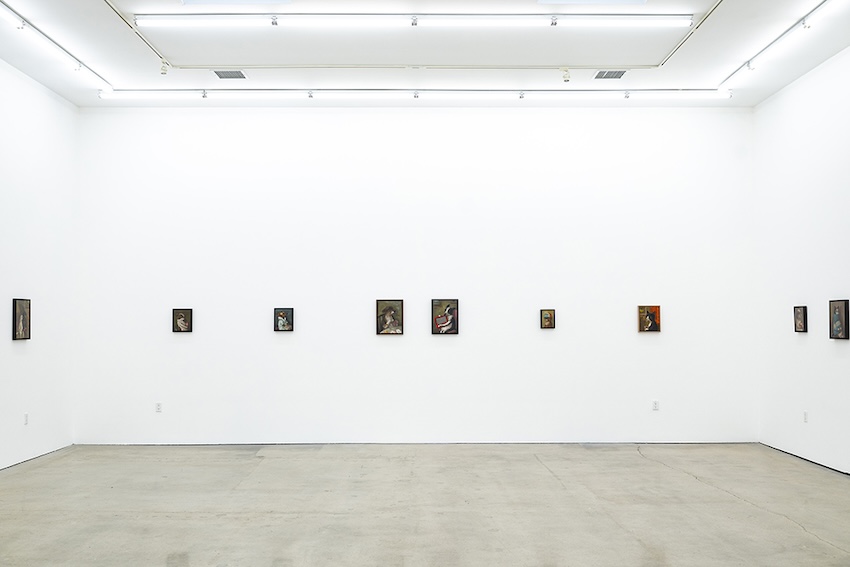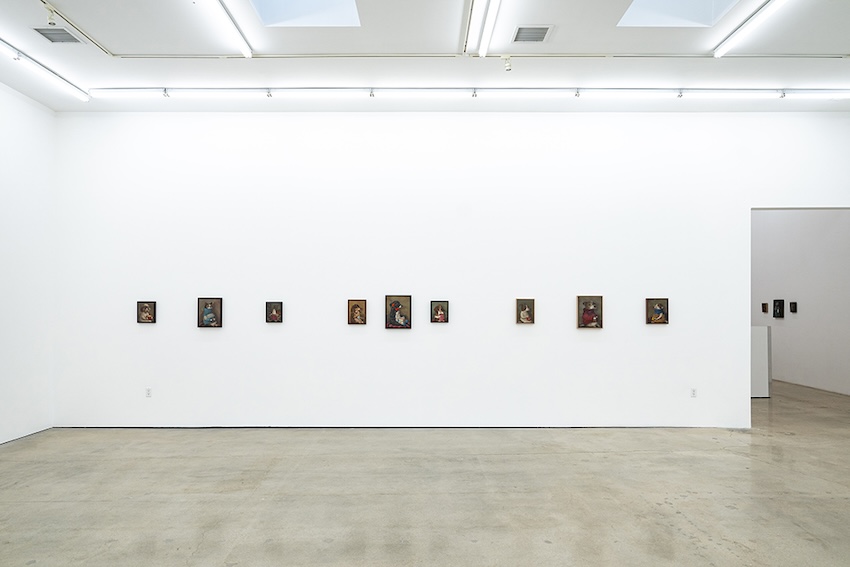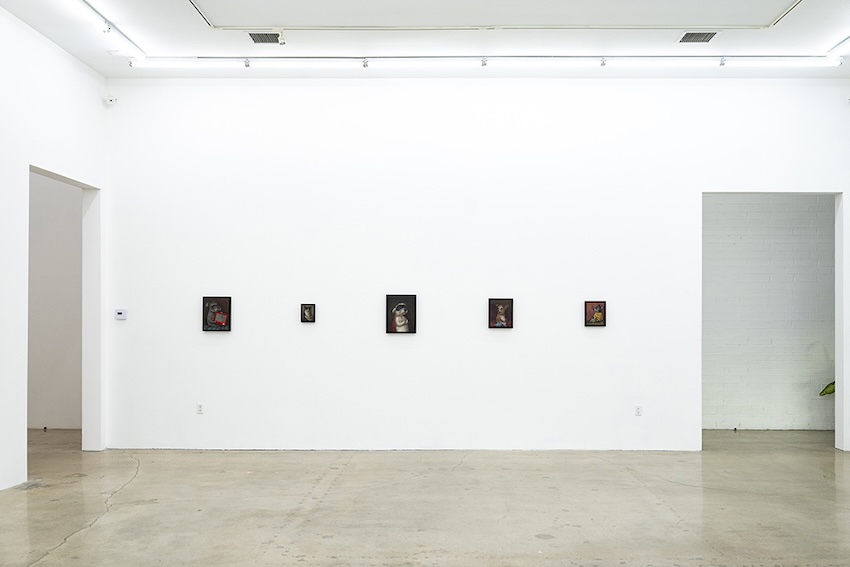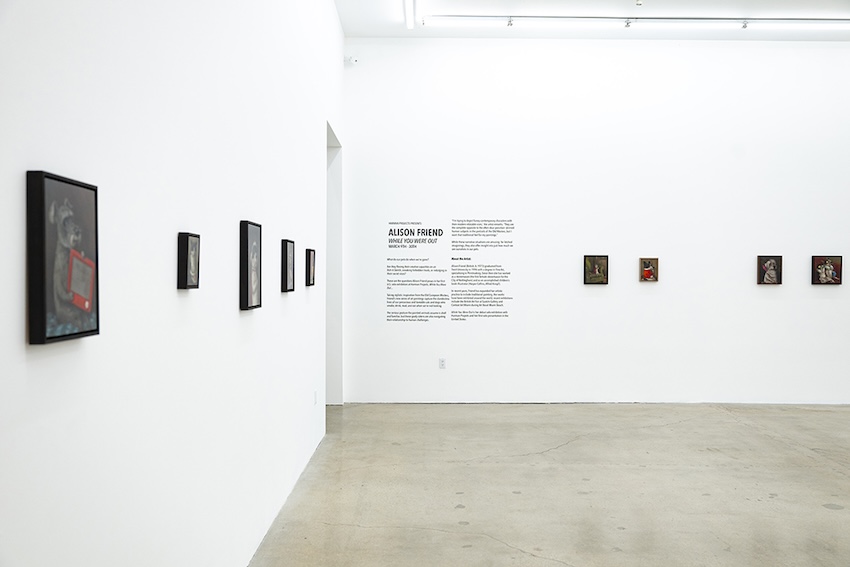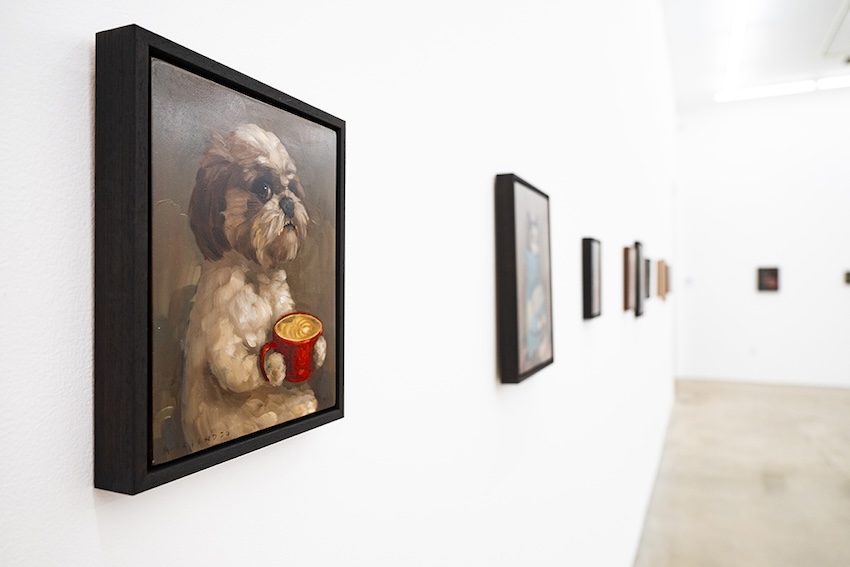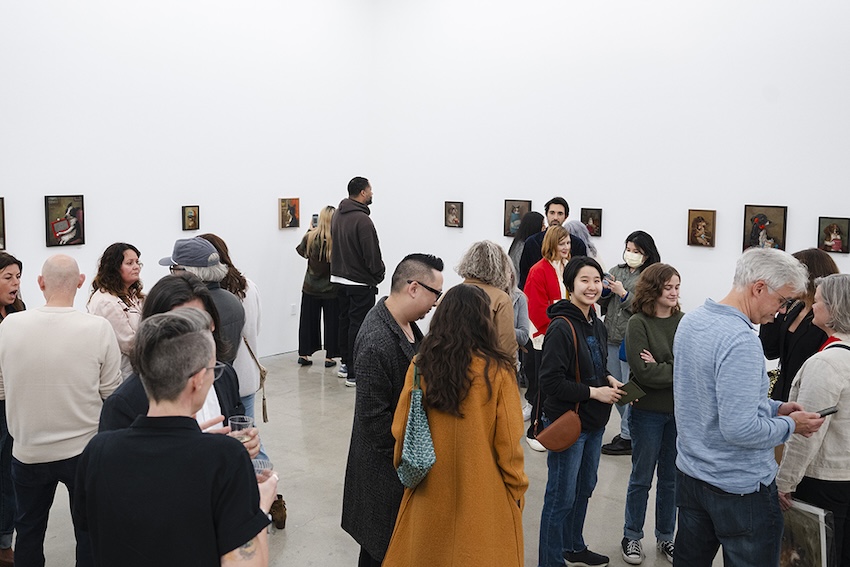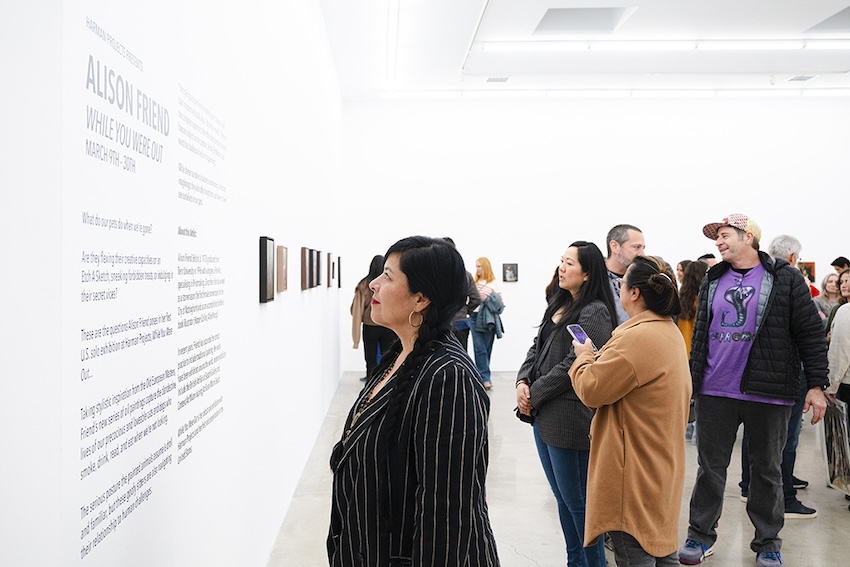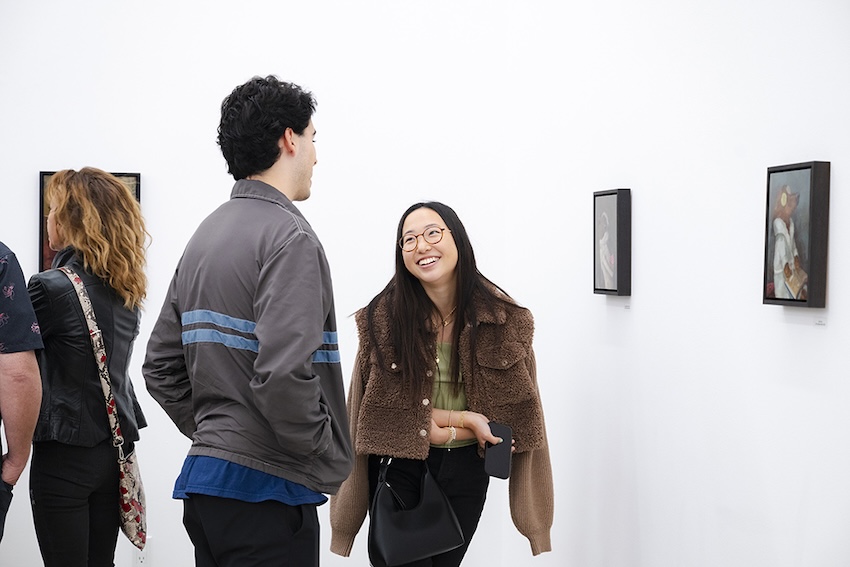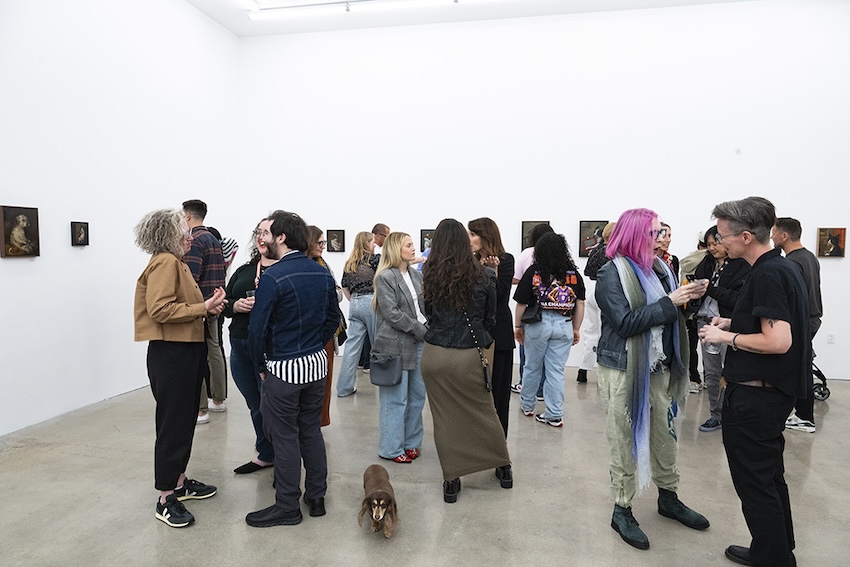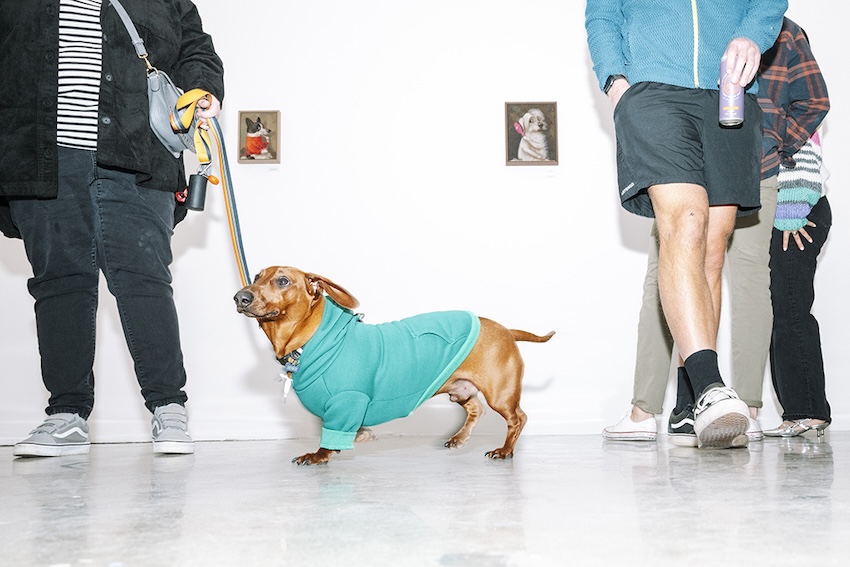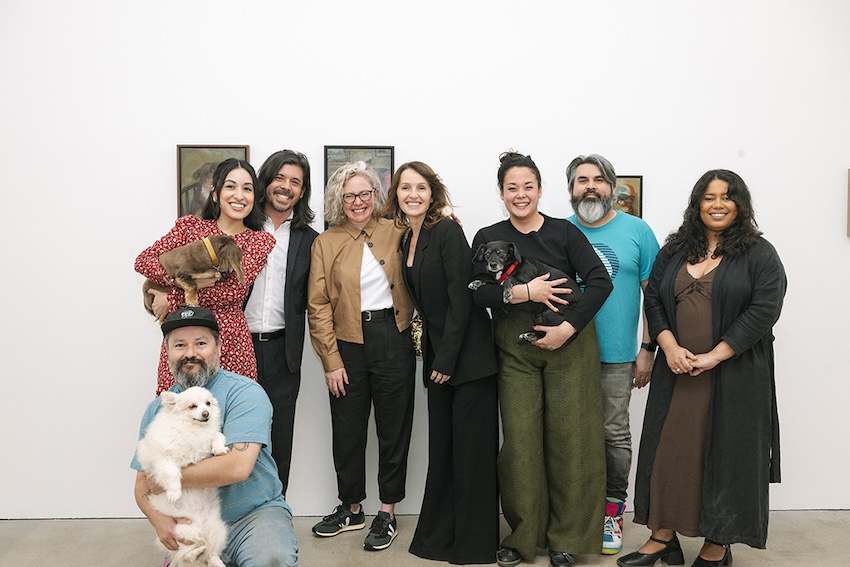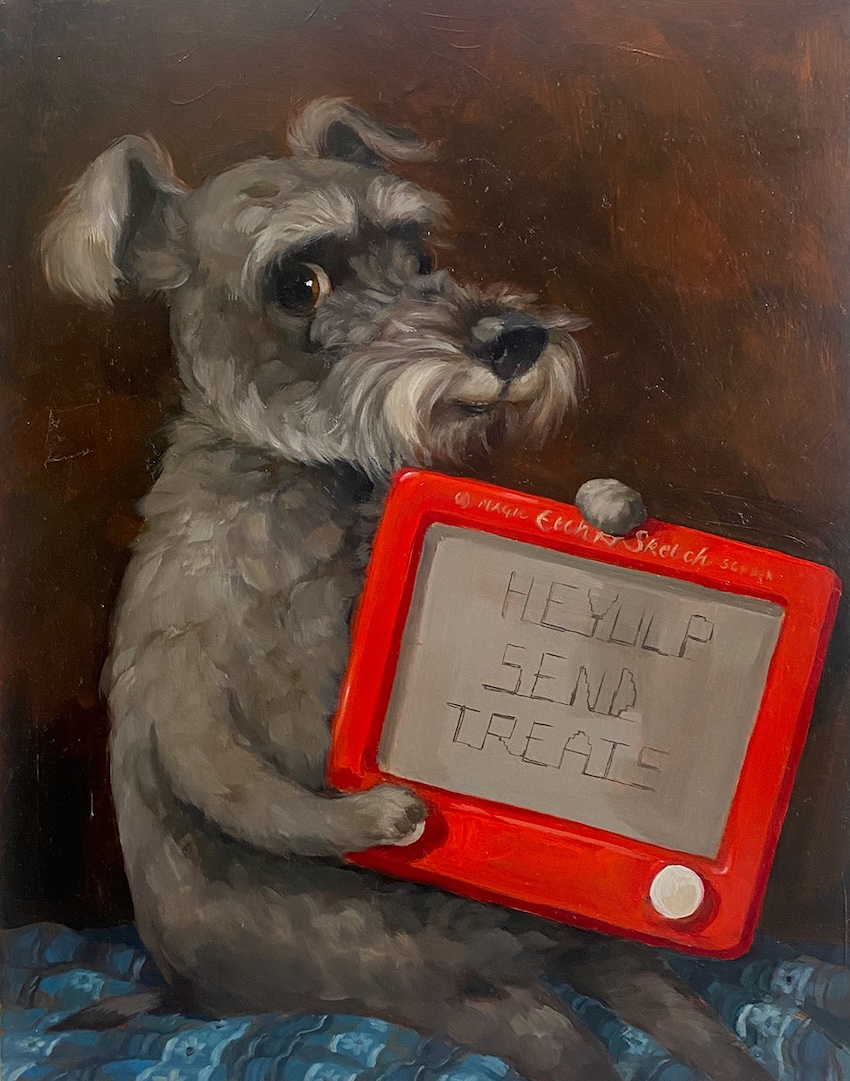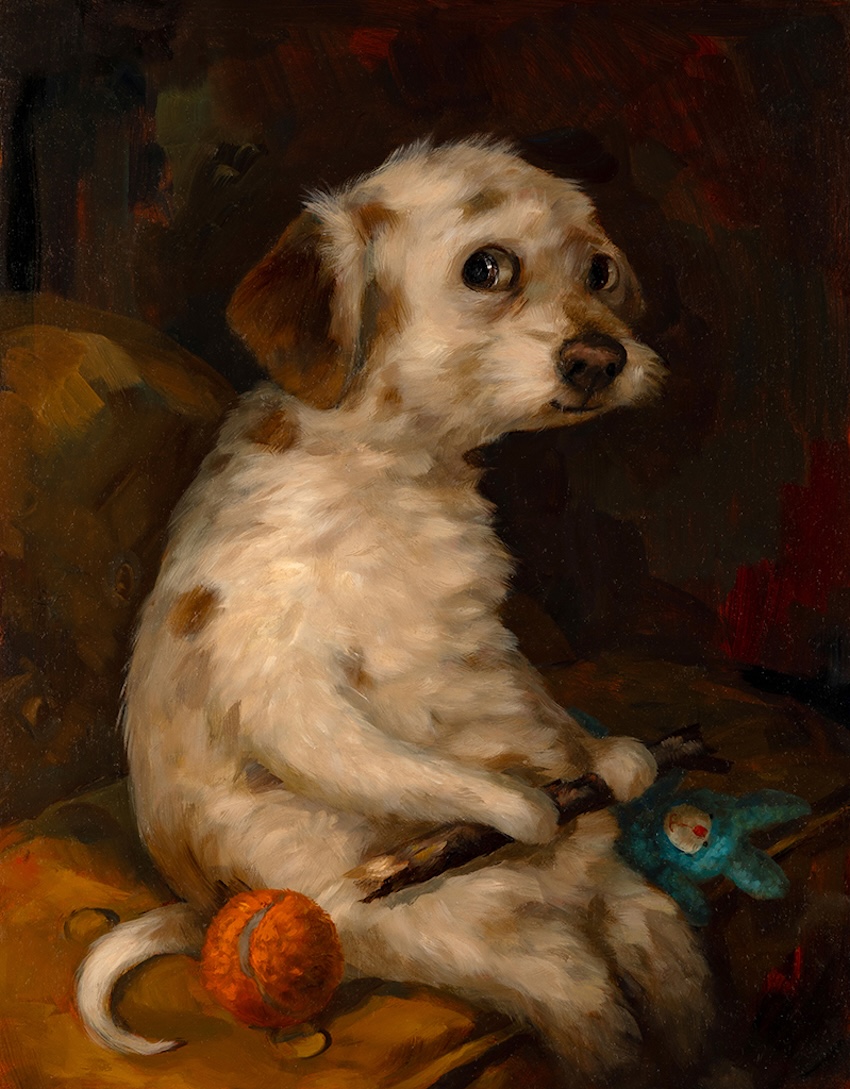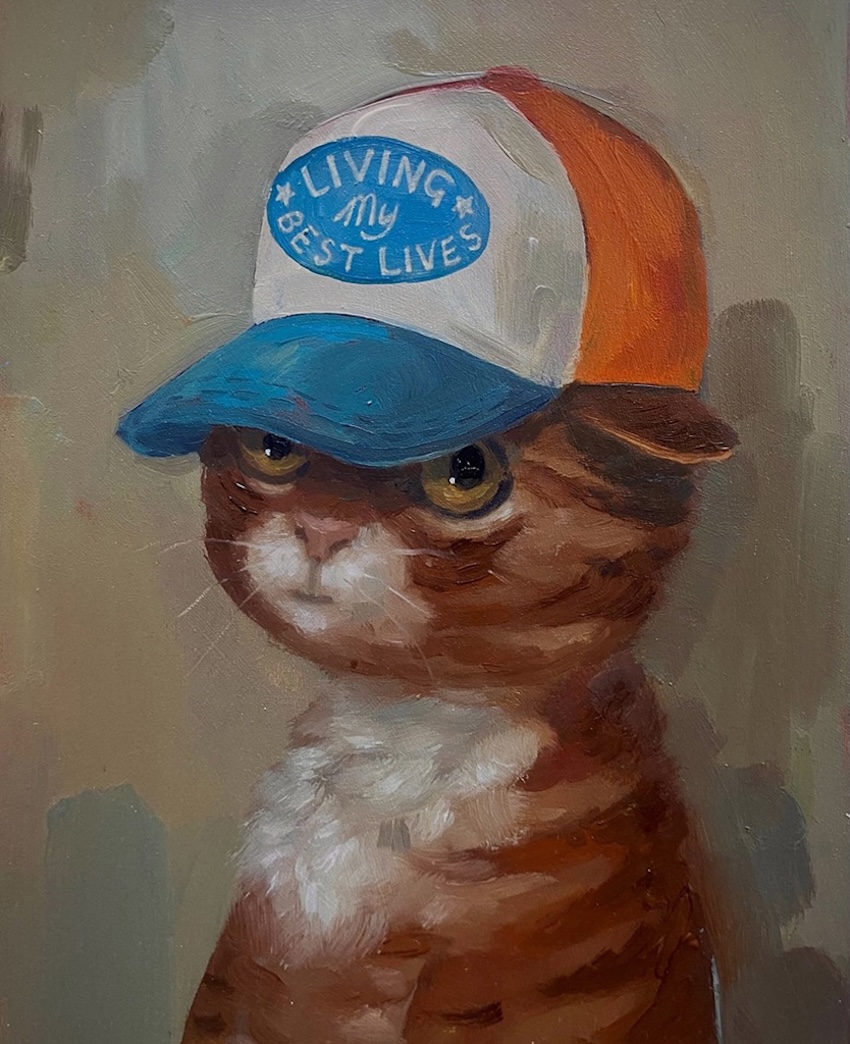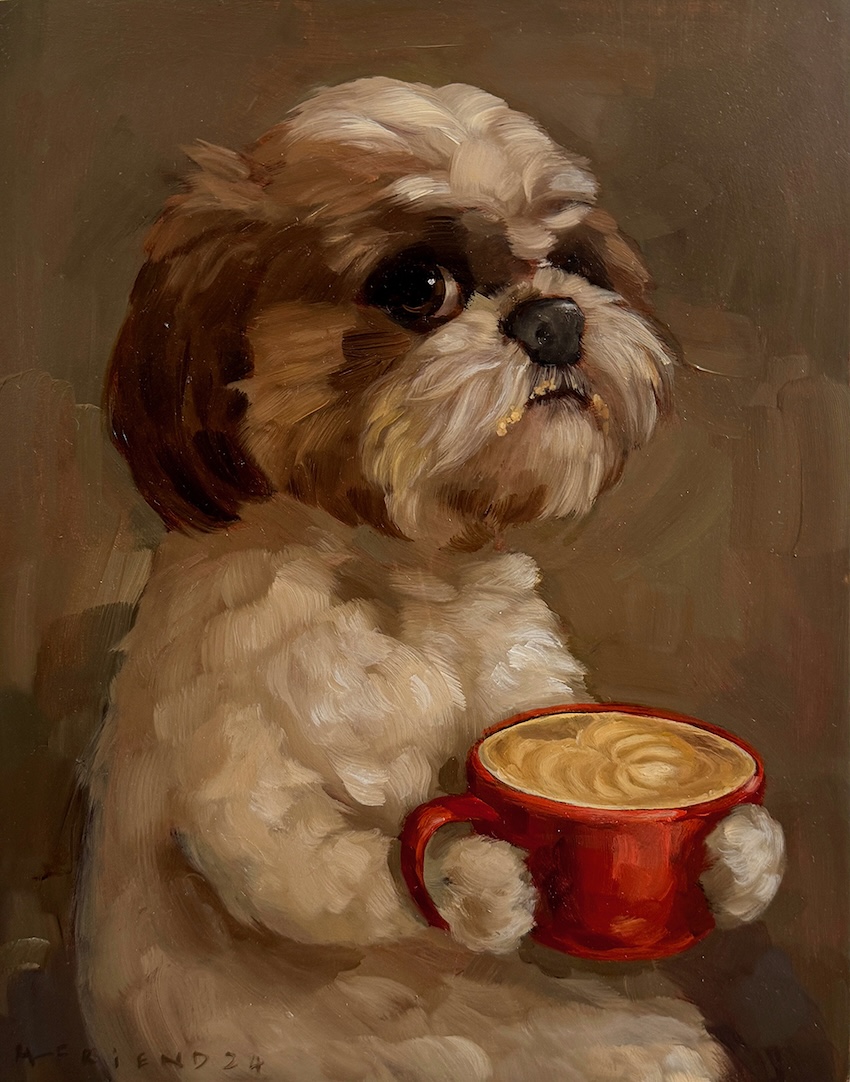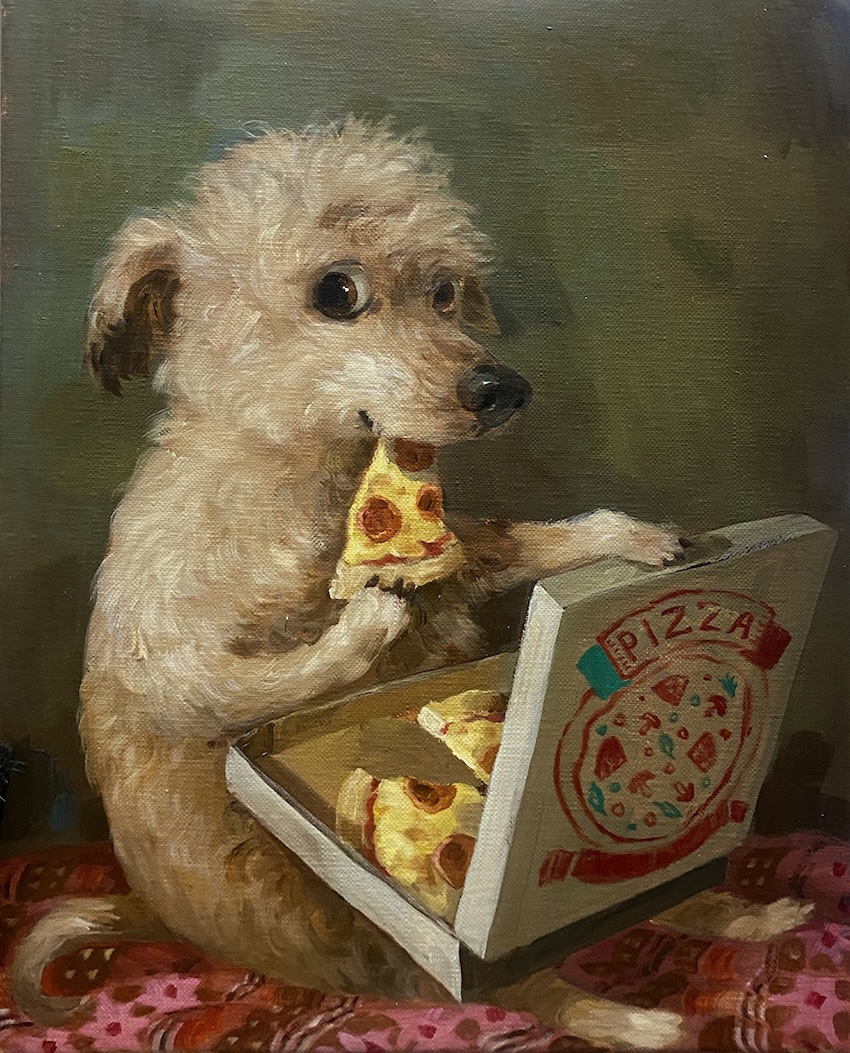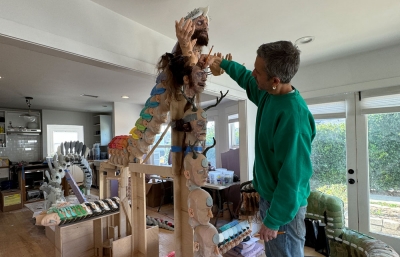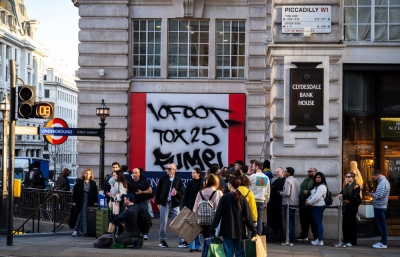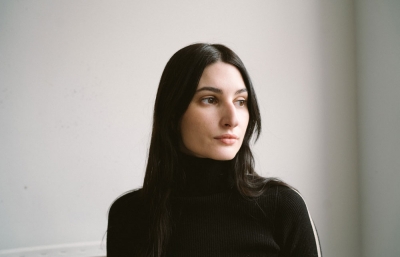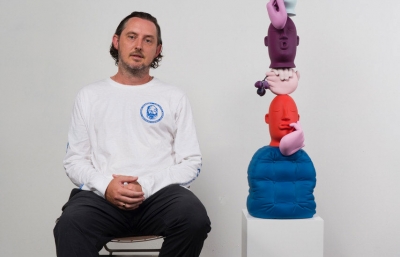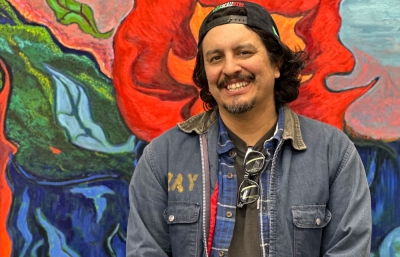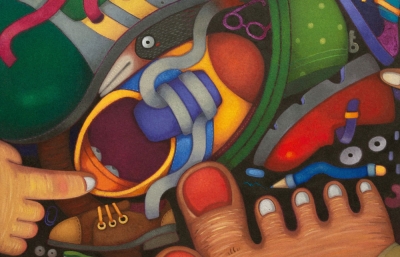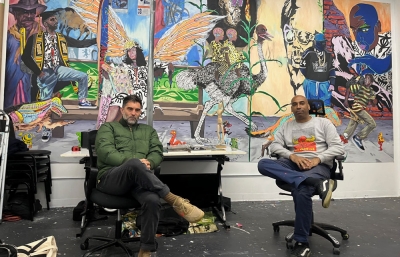An artist’s first solo exhibition of paintings in the United States doesn’t happen every day. That’s why Alison Friend’s solo exhibition While You Were Out... at Harman Projects in Los Angeles is a remarkable debut. Blending humor and levity with the subdued palette and technique of the Old European Masters, Friend’s new series of oil paintings capture the clandestine lives of our precocious and loveable cats and dogs who smoke, drink, read, and eat when we’re not looking.
Before her exhibition, Harman Projects caught up with Friend in her U.K.-based studio to talk about her identity as an oil painter, how not to cross the line into caricatures, and what single facial features and clothing items can make or break an animal character.
Harman Projects: Alison, the title of your solo exhibition is While You Were Out... To me, these are the glimpses into the lives of our animals while we’re away from the house—the rich lives we imagine they lead when we aren’t looking. Has there ever been a time you clued into your pet’s secret personal life?
Alison Friend: Yes completely all the time! Well, not really, but it’s a lot of fun to imagine right? I have walked into the room plenty of times and the dog looks at me like I’ve interrupted something. I’ve also known people who have a dog and a cat who don’t get along but as soon as you leave the house they’re snuggled up together. There’s definitely stuff happening that we don’t know about.
I remember in an interview you gave a while back you said you didn’t have a particular penchant for depicting any specific animal, but there are certainly a lot of dogs in this body of work. Why dogs?
You’re right. I have always loved dogs. Give me a dog over a person any day!
I also think people connect with the dog paintings. They recognize those looks I try to capture. I very rarely paint cats, but these days I'm painting a lot of them. I think in the early days, a lot of my characters were bunnies and bears. Maybe I was influenced by the kind of books I was illustrating. If you look back at some of my picture books, bears and bunnies feature quite a lot!
Your fondness for dogs is apparent not only in your work but in your life—you auctioned off the painting Pizza Lover to raise money for Paws for Life K9 Rescue, and raised $12,000! Why was it important for you to do this?
I just think if I can use my skills as an artist to potentially help or make a difference, why wouldn’t I? Shelters are full to the brim with dogs who are there through no fault of their own. The hardest part is donating money to one place when all these shelters are so much in need.
You’ve mentioned that the eyes and eyebrows are the key to imbuing an animal with anthropomorphic qualities. This is so evident in your paintings—how the animals are often shown at a 3⁄4 angle while glancing at the viewer, their brows suspicious, guilty, or curious. The painting I Love This Stick, for example, shows a little dog with tiny raised eyebrows as though he’s been caught in the act or hoarding his prized possession. Can you expand on how you make animals so human, and what decisions you make about their expressions while painting?
I stand by this: The eyes and the eyebrows are the most important for character and expression... well, for human-like expressions. Of course, animals don’t actually have eyebrows as such but you give a dog or a cat or any animal eyebrows and they look hilarious—you open up a whole volt of expressions.
At the beginning of a painting, I keep the outline of the character very loose, and—a few brush marks can create a particularly funny expression and all of a sudden, there they are! It sometimes throws up a surprise and the character goes in a direction I wasn’t intending, so I go with it a lot of the time.
Can you walk us through your thought process when making a painting?
I always want the viewer to be part of the creative process. As much fun as it is to illustrate a whole story, I have to admit that I prefer painting a single moment. In a way, it has to deliver more information about that character in that single scene than is often described in multiple pages of a picture book. There needs to be enough narrative for the viewer to think about that character's bigger story.
There’s something humorous or ironic about depicting these saucy animals in a style and medium that evokes the regal art history of oil portrait painting. You’ve mentioned that you’re inspired by the European Old Master painters, which shows in the palette and composition of the works. I think of how generations of British Aristocracy, including Anne Boleyn or even Elizabeth I, are painted with their heads or bodies turned at a 3⁄4 angle, looking to the side at the viewer. Can you say more about the dichotomy you alluded to between the sort of silly subject matter and the style in which you depict your subjects?
I’m trying to depict funny contemporary characters with their modern relatable vices, like snacks, booze, and cigarettes. They are the complete opposite of the often dour porcelain-skinned human subjects in the portraits of the old masters, yet I want that old traditional feel for my paintings. Of course, these aren't human subjects, I anthropomorphize my animals by using familiar tropes seen in the Old Master's portraits: the pose, they sit for their portraits in a very human way, their hand-paws resting on the lap. They often have the same dour expressions as their Old Master counterparts... particularly the cats.
Where and how do you not cross the line from character into caricature?
The color palette plays a big part in this, but MOST important is the rendering of the fur and the choice of background or the character’s surroundings. This places them somewhere that feels real, so despite their funny almost human expressions, and sometimes dubious anatomy, I think they are believable as real characters. I come very close to crossing the line in some paintings but these things help me stay on the right side of it.
Are there any hidden stories within your works?
There are things from my childhood scattered throughout my work, like my memory of certain interiors. The fleur de lys wallpaper is from my mum’s living room and features quite a lot in my paintings. It brings back memories of the home I grew up in and my mum, so it will keep appearing. Ornaments, paintings on walls, chairs, textiles. All very nostalgic... and then there’s the snacks!
You’ve also mentioned that you work best at night. Is that still true? What about the nighttime makes you so creative?
I am indeed a bit of a night owl. It’s quiet. No one is bugging me on email, I can put an audiobook on and just get into painting. I think it also stems from having a son and after his bedtime I would settle down to some work. He’s 17 now so that’s not really a thing but I still work better in the evening. This is when I work at my home studio. Half of the time I work in my partner’s studio in Manchester and there are no distractions. We’re there to paint and it’s wonderful.
The animal characters in your paintings often have some type of accessory, be it a scarf, a blanket, or even a snack. What’s the best accessory we can give an animal?
Oh tough question! It has to be a wooly sweater or a hand knitted jumper all the way! . I would say a hat but ears can be problematic... though also very funny, like in my series of cats in trucker hats. I really didn’t know what to do for the best with those cat ears. I do have one kind of unwritten rule—just one item of clothing!
While You Were Out... is on view at Harman Projects Los Angeles, 2754 S La Cienega Blvd Suite B, through March 30th. Exhibition installation and opening night photos were taken by Chloe Rice.


